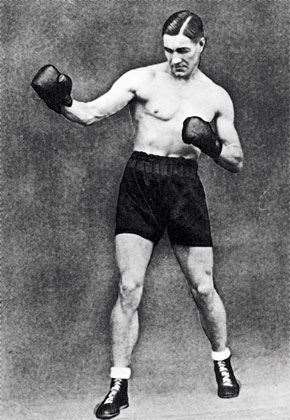Boxing trainer Ambrose Palmer’s system of fighting was dubbed “The Method”.
Boxing trainer Ambrose Palmer’s system of fighting was dubbed “The Method”.
 The legendary Ambrose Palmer takes aim.
The legendary Ambrose Palmer takes aim.Images: Getty Images
Ambrose Palmer’s unique one-handed technique set tongues wagging and helped legendary Australian Johnny Famechon to world championship glory.Boxing trainer Ambrose Palmer’s system of fighting was dubbed “The Method” by Johnny Famechon’s biographer, Frank Quill, who collaborated with “Fammo” on a book about this amazingly effective boxing style. Palmer himself had been an elusive and solid-punching fighter; a world-rated light-heavyweight. He’d also played Australian rules football for Footscray and won several professional sprints. He was a gentleman sportsman, and a thinker.Famechon, born of great French boxing stock, was a skinny kid when he first entered Palmer’s gym, but, conscious of the tradition in his blood, he was a keen learner. So faithful was Famechon to Palmer’s ways that when he took up dancing lessons to impress the girls, he couldn’t bust a move. Ambrose had taught him to dance, and it was the only dance that mattered.Anyone who saw “Fammo” had never seen anything like him. We’ve never seen his like since. He beat the seemingly unbeatable Jose Legra for the world featherweight title in 1969, and lost it, controversially, in 1970 to the undefeated, comebacking ex-champion Vicente Saldivar.
As a trainer, Palmer’s method was based on a non-negotiable bottom line. To “hit and not be hit” was, to Palmer, the entire point of boxing. The style he developed was based on the left jab, which was to be fast, relentless, accurate, always in the face and body of onrushing opponents and endlessly piling up points. That jab was often conveyed with an unconventional upright fist for machine gun delivery. Lateral movement, founded on leg stamina and hip and waist strength, was to be swift, its choreography practised endlessly in the gym.Palmer would use a frame to keep his fighters’ feet together as they lay on their backs doing leg raises and rotations, strengthening their midriffs – vital for the twists and low ducking evasions of Palmer’s way. Famechon would duck so low he could sniff the canvas, and perform this manoeuvre in the same time it would take for another fighter to slip a punch with a small head movement.The right hand (for an orthodox fighter) was considered a high-risk punch by Ambrose – a last resort. Throughout the duration of a fight, that glove was be glued to the chin, and rather than closed into a fist, it was to be open, the last line of defence if an opponent happened to catch The Method’s mercurial exponent.
At times, Palmer’s fighters would spar with the right hand fixed in this position – via a tie he’d slip over their heads and around their wrist – and rendered useless as an attacking weapon. But the left would become so deft and nuanced, one could imagine Famechon picking a lock wearing eight-ounce boxing gloves in the same instant it took him to throw one of those jabs. According to Fammo, Palmer’s gruelling gym workouts were characterised by “speed and more speed”. Fammo was an all-action fighter, his elusive style something other fighters could only aspire to.
 In the ear of world champ Johnny Famechon as trainer.
In the ear of world champ Johnny Famechon as trainer.Image: Getty Images
The Method was based on scoring, and if Fammo wasn’t striking, he was waiting for them to strike so he could counter.That right glove, always open, always stuck to the left jaw, was the most unusual thing about the style. Of course, it had its pay-off. In his last few fights, it was felt Fammo’s seldom-thrown right shocked opponents, but he never threw it enough.Fammo was an almost hyperactive practitioner who never stopped moving and never once abandoned his method, even when in trouble. Palmer made his fighters fit enough to carry out his technique under any conditions.
In fact, Famechon demonstrated a very important sporting principle: no matter what technique you choose, master it in all circumstances, and if you conquer your own system, you’ll be well-nigh unconquerable. Fammo’s victory over Legra was a triumph of technique over dash. In his first fight against Fighting Harada, Fammo was dropped brutally. His head hit the canvas hard. He broke his ankle. Yet, when he staggered to his feet, his main concern was not to survive, but to resume his technique as quickly as possible. Immediately he had Harada chasing him. Fammo’s head cleared, and he won.In 1976, Rocky Mattioli became world light-middleweight champ long after he’d left Ambrose to take up residence in Italy. Today, the “Rock” realises that the tight defence he carried throughout his career (even with his “slugger” reputation), the ability to throw a winning left jab and the desire to prevail with superior technique were all Ambrose’s doing. “He was”, the Rock growls now in his Milanese accent, “the man who made me a world champion.”
Many used Palmer’s way to win Australian, Commonwealth and world championships: Australia’s Jack Johnson, Max Carlos, Foster Bibron, Paul Ferreri, Mattioli. But Famechon became the exemplar of The Method. He retired unmarked, the only world featherweight champ to retire without the blemish of a knockout or stoppage loss on his record.
– Robert Drane
Related Articles

Feature Story: Moving the Needle

The Aussies at The Open







.jpg&h=115&w=225&c=1&s=1)
.jpg&h=115&w=225&c=1&s=1)




